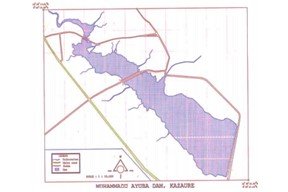Evaluation of physicochemical parameters in wastewater from Muhammad Ayuba dam in Kazaure, Jigawa state, Nigeria
Abstract
Evaluation of physicochemical parameters namely alkalinity, biological oxygen demand (BOD), chemical oxygen demand (COD), conductivity, dissolved oxygen (DO), hardness, pH and total dissolved solids (TDS) in the wastewater samples collected from Muhammad Ayuba dam in Kazaure, Nigeria. The study was conducted during harmattan season for a period of three months from November, 2019 – January, 2020. All the parameters were analysed using conventional methods. The results showed their concentrations were in the range of 1.00 – 1.50 mg/L for alkalinity, 3.00 – 3.45 mg/L for BOD, 12.45 – 24.00 mg/L for COD, 745 – 1200 µS/cm for conductivity, 5.50 – 6.30 mg/L for DO, 1.82 – 2.45 mg/L for hardness, 7.20 – 7.90 for pH and 410 – 440 mg/L for TDS. The concentrations of these parameters in the wastewater were observed less than World Health Organization (WHO) tolerance limits with exception of electrical conductivity that was above 1000 µS/cm after four weeks of investigation. This study revealed gradual build-up of various ions in the dam water due to the mixing of contaminated wastewater from the adjacent community. Therefore, the periodical monitoring of different physicochemical parameters of the dam water should put in place as to evaluate their environmental impacts and possible potential risks.
Keywords:
Alkalinity, BOD, Conductivity, Hardness, WastewaterDownloads
References
Ademoroti, C.M.A. (1996). Standard method for water and effluents analysis. Foludex press ltd., Ibadan. pp. 22 -112.
Adepelumi, A. Ako, B. and Ajayi, I.T. (2001). Groundwater contamination in basement-complex area of Ile-Ife, southwest, Nigeria. A case study using the electrical resistivity of geographical method. Hydrogeology Journal, 9: 611 -622.
Agency for Toxic Substance and Disease Registry (ATSDR, 2009). Toxicological profile for zinc. Atlanta GA; US department of human health and services. Public Health Service http: www.atsdr.cdc.gov/toxprofiles/tp2.html...
Akan, J.C. Abdulrahman, F.I. Dimari, G.A. and Ogugbuaja, V.O. (2008). Physicochemical determination of pollutants in wastewater and vegetable samples along Jakara wastewater channel in Kano metropolis, Kano state, Nigeria. European Journal of Scientific Research, 23: 122 -133.
Akubugwo, E.I. Ude, V.C. Uhuegbu, F.O. and Ugbogu, O. (2012). Physicochemical properties and heavy metals content of selected water sourced in Ishiagu, Ebonyi state, Nigeria. Journal of Biodiversity and Environmental Sciences, 2: 21 – 27.
American Heritage Dictionary for the English Language (AHDEL, 2004). Biochemical oxygen demand. 4th Edition, Houghton Mifflin company assessed on 21/08/2010 http://dictionary.reference.com/browse Biochemical oxygen demand>
American Public Health Association (APHA, 1998). Standard methods for the examination of water and wastewater, 18th edition, Washington, DC pp. 45-60.
Brake, P. (2007). A bug’s eye-view of the BOD Test. Washington state department of ecology. Olympia Washington, USA.
Chapman, D. (1997). Water quality assessment. A guide to the use of biota, sediments and water in the environmental monitoring, 2nd edition, E & FN Spon, London, File: A//:/Hydrology and Water Quality of Lake Merced.htm.
Goldman, C.R. and Horne, A.J. (1983). A textbook of limnology. 2nd edition, McGraw Hill book Co., New York, pp. 464 -470.
Ikem, A., Osibanjo, O., Sridhar, M.K. and Sobande, A. (2002). Evaluation of groundwater quality characteristics near two wastes sites in Ibadan and Lagos, Nigeria. Water, Air and Soil Pollution, 14: 307-333.
Kumar, V., Kumar, S., Srivastava, S., Singh, J. and Kumar, P. (2018). Water quality of River Ganga with reference to physico-chemical and microbiological characteristics during Kanwar Mela 2017, at Haridwar, India: A case study. Archives of Agriculture and Environmental Science, 3(1): 58-63.
Kumar, V., Singh, J., Thakur, R.K. and Kumar, R. (2016). Hydrobiological characteristics of pond water at Jamalpur Kalan, Haridwar (Uttarakhand), India. Journal of Environmental Science, Computer Science, and Engineering & Technology, 5(3), 546-557.
Metcalf, R.C. and Peck, D.V. (1993). A dilute standard for pH, conductivity and acid neutralizing capacity measurement. Journal of Freshwater Ecology, 8: 67-72.
Oladeji, S.O. and Saeed, M.D. (2018). Effect of phosphate levels on vegetable irrigated with wastewater. IOP Conf. Series: Materials Science and Engineering, 342.012093, https://doi.org/10.1088/1757-899X/342/012093.
Oladeji, S.O. (2017). Impact of wastewater on nitrate concentrations in soil and vegetables grown along Kubanni river Zaria in Kaduna state, Nigeria. Archives of Agriculture and Environmental Science, 2(4): 318-324, https://doi.org/10.26832/24566632.2017.020413
Olorunsola, E.O., Isah, A.B. and Allagh, T.S. (2011). Effects of varying condition of acid hydrolysis on some physicochemical properties of Ipomoea batatas starch. Nigeria Journal of Pharmaceutical Sciences 10: 12- 20
Sharma, J.D., Sharma, M.K. and Agrawal, P. (2004). Effect of fluoride contaminated drinking water in Albino rats (Rattus norvegicus). Asian Journal of Experimental Sciences, 18: 37-46.
Sodipo, O.A. Abdulrahman, F.I. and Akan, J.C. (2012). Comparative elemental analysis of Solanum macrocarpum (L.) and soil sample from Alau, Borno state, Nigeria. Journal of Research in Environmental Science and Toxicology, 3: 36-40.
Standard Organization of Nigeria (SON, 2007). Nigerian standard for drinking water quality, NIS – 554 Lagos, Nigeria.
US-EPA. (2001). Definition and procedure for the determination of the method detection limit, Revision 1: 1140 CFR 136.
US-EPA. (2007). National primary drinking water regulation for lead and copper, Federal Registry, 53: 31515-31578.
WHO (1985). World Health Organization. Toxicological evaluation of certain food additives and contaminants, Cambridge University press, Cambridge, pp. 163-219.
WHO (1999). World Health Organization. Guidelines for drinking water quality, Health criteria and other supporting information (2nd edition Vol.2) AITBS publishers, New Delhi pp. 119-382.
WHO (2006) World Health Organization guidelines for drinking water quality. Health criteria and other supporting information. Vol. 1, 3rd edition, New-Delhi, pp. 73 -75
Yasmeen, K. Versiani, M. Arain, R. Haque, Q. Khan, N. Ali, S. and Langha, A. (2010). Enhanced metal levels in vegetables and farm soil irrigated with industrial wastewater. Journal of Applied Science, Environment and Management, 14: 95-99.

Published
How to Cite
Issue
Section
Copyright (c) 2020 Agriculture and Environmental Science Academy

This work is licensed under a Creative Commons Attribution-NonCommercial 4.0 International License.

